The device is a typical dishwasher: the principle of operation and the purpose of the main nodes PMM
The increase in the area of kitchens in new buildings allows you to accommodate a lot of useful equipment, including a dishwasher (PMM). This appliance simplifies the maintenance of dishes and provides more time for leisure.
The functionality and design of the dishwasher may differ for different models, so when choosing this technique, you must initially study in detail its characteristics.
In this article we will get acquainted with the design features of the dishwasher, consider the purpose and arrangement of the work units. We also talk about the purpose and maintainability of various elements.
The content of the article:
Design components of the dishwasher
Dishwasher is a complex technique, which is increasingly becoming one of the essential attributes of modern kitchen. If you are in doubt about the need to purchase it, we recommend that you familiarize yourself with arguments for and against.
The main function of the dishwasher is to clean the dishes embedded inside the dishwasher. But ensuring a good result is possible only with the correct operation of its nodes.
The main details of the dishwasher include:
- Control Panel.
- Hermetically sealed inner chamber.
- Blocks of sprayers (rocker arm).
- Circulation pump, providing return to the spraying of flowing water.
- Compartment for detergent, rinse aid, water softener.
- Baskets for dishes, shelves for glasses.
- Water filter system.
- Flowing heating element.
- Float switch.
- Power cord.
- Water inlet valve.
- Drain pump.
- Hose system.
- Pressostat.
- Lamp.
The listed details form the basis of a typical PMM, but other modules may be provided in its design. The user can view only the interior of the washing chamber.It is in it that the basic elements responsible for the cleanliness of the processed dishes are located.
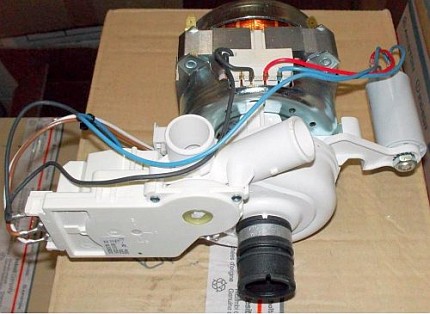
Behind the door of the dishwasher hides an internal space with a mechanism that is directly responsible for cleaning the dishes.
Not in all devices it is the same: expensive PMMs provide spraying from all sides, and the cheapest ones only from below.
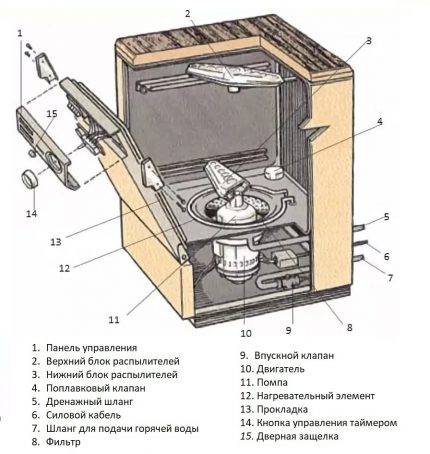
The main parts located inside the working space of the dishwasher are:
- PMM case. Made of stainless steel. Its walls do not experience strong mechanical stress, so the thickness of the metal in the tank is minimal.
- Rocker arms for spraying liquid under pressure. They do not have a special drive, but rotate due to the oblique arrangement of several outlet openings.
- Baskets for laying dishes. There can be several of them in the inner space. The size of the baskets is usually different: below is more spacious for pots, and at the top - compact for plates, mugs, cutlery.
- Filter system. It is located in the lower sector of the tank, consists of the upper grid and the lattice cup located below it.
- Compartment for loading funds. Designed for detergent, rinse aid and water softener. These three containers can be located separately or connected in the framework of one dispenser.
- Sealing gum and a light bulb.
Without these components, the dishwasher simply cannot perform its functions efficiently. But inside the PMM, other elements can be installed that provide advanced features and make it easier to work with the device.
Types of modern models
Not all apartments have spacious kitchens that can accommodate full-sized dishwashers. Therefore, manufacturers have invented many alternative devices that can wash dishes and not take up much space. All of them are exclusively electric with forced pumping of water pressure.
Four structural types of PMM can be distinguished:
- Built-in under the countertop.
- Standing apart.
- Compact portable.
- With vertical loading.
PMMs built under the countertop usually have a depth of 57 cm, which allows the necessary communications to be drawn between the apparatus and the wall. But different models can differ significantly in their characteristics from each other, which should be considered when choosing a suitable dishwasher.
With proper installation, the front edge of the built-in machine with a depth of 57 cm will be flush with the table. More information about installing a built-in dishwasher we wrote here.
The width of the dishwasher can be compact (44-46 cm) or full-sized (56-60cm). Their height is usually standard - 81-82 cm with the ability to adjust.
Freestanding PMMs are equipped with a beautiful and durable top panel on which you can put any things.The vibration of the machine during operation is minimal, so you can not worry about slipping objects. More about the characteristics of freestanding machines and features of choosing the best we talked in the next article.
Such devices are installed either near the edge of the countertop, or in the next room, where there are necessary communications. The dimensions of freestanding PMMs are similar to those built-in.
Compact portable dishwashers are convenient for living in rented apartments. They do not require installation work and can be installed both on the floor and on the table. A typical size of such a PMM is 44 * 55 * 50 cm, which should consider when choosing.
To connect them, simply connect the flexible hose to the water tap and lower the drain pipe to the sink.
Vertical loading PMMs are rarely produced. They usually have the same level of bookmarking the dishes, therefore they are functionally limited.
Regardless of the type of dishwasher, their principle of operation is similar. However, the technical features of the models still affect the quality of cleaning dishes and the energy efficiency of the apparatus as a whole.
Additional PMM functionality
Above were considered the basic configuration of dishwashers. Inexpensive models from different manufacturers have approximately the same cost and functionality, so they differ little from each other.
But there are also premium class dishwashers that provide consumers with additional options.
Such devices may include the following non-standard components:
- Devices for drying dishes: additional heating elements, fans, heat exchangers, ventilation ducts.
- Automation to protect the control panel and door from the actions of children.
- Guide rails for convenient installation of baskets in the working chamber.
- Seamless control panels that look stylish and easy to clean.
- Indicators of the remaining time until the end of the wash and the duration of each washing step.
- Built-in water softener. It serves quite a long time and is subject to regular regeneration.
- Additional tubes for connecting hot water directly from the water supply.
- Sensory system that determines the need to add softening salt to water. Sometimes it works completely automatically paired with a metering device.
- Block for detergent "3-in-1", which allows you to install one cartridge with detergent, rinse aid and softening salt.
- Built-in heat exchangers that reduce temperature differences and increase the energy efficiency of PMM.
- Water purity sensor. It helps determine when rinsing is complete, saving time and energy.
- The "beam on the floor" system. It is a light indication projected onto the floor, allowing you to evaluate the current operating mode of the device.
- System for regulating the height of baskets with utensils.
- Drying sensor, allowing to determine its optimal mode, based on the characteristics of external air.
Professional devices include most of the listed devices, which ensures high quality dishwashing, energy efficiency and ease of use.
But it should be understood that every additional part in the dishwasher increases its cost.
The scheme of the dishwasher
Modern PMM is a complex device.To understand the functional significance of its nodes, you should step by step consider the principle of operation of the device.
So, when washing dishes in the dishwasher, the following processes occur.
- The dishes are loaded, the necessary washing mode is selected and the machine starts.
- The inlet valve opens, water begins to accumulate, the heater turns on.
- When the pressure switch is activated, the inlet valve closes.
- Detergent is added to the water, salt, although the latter may be constantly in the flow compartment.
- The circular pump is turned on, and water begins to beat under pressure from the nozzle openings, spinning them.
- Draining and filtering, the water again enters the pump through the salt tank.
- After the wash cycle, dirty water is pumped into the sewer, and clean and cold are collected instead. The first rinse cycle begins.
- After the first rinse, the liquid is drained by the pump and new water is collected. It is heated, and then added to it rinse aid. The second rinse cycle begins.
- After the second rinse, the water is drained into the sewer and the drying process begins.
Drying the dishes ends the working cycle of the dishwasher.
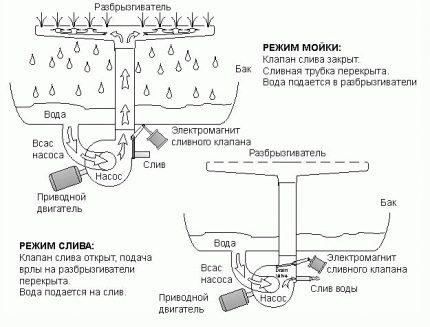
To ensure high-quality washing, it is advisable to wipe the dishes from large pieces of food before placement in the PMM. Then all the dirt will be washed off after the washing step and will not get on the product during the rinse.
Types of drying in the dishwasher
Sometimes PMM has to be downloaded several times in a row. Such situations require faster wash cycles. They can be reduced by stimulating the drying of dishes.
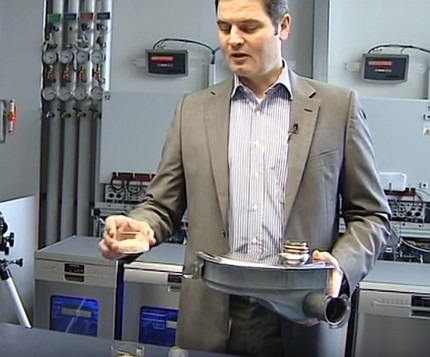
In total, 3 types of drying are used in dishwashers:
- Condensation. It is the usual drying of warm drops on the dishes and their subsidence on the cold side walls. This process is passive and lengthy.
- Turbo dryer. Fans supply warm air to the machine through the heating elements. This drying method is the fastest, but requires increased energy costs.
- Intensive dryingin which the passive flow of fresh air into the inner chamber is stimulated by convection flows. For this, the PMM is equipped with air intakes.
In some models of dishwashers, it is possible to choose between several types of drying. All of them have their own characteristics, and you can turn them on, based on the need to quickly release the PMM.
Maintainability of PMM parts
Almost all parts of the dishwasher are replaceable. But part of the repair work can be performed by the user himself, and part can only be carried out by specialists of the service center.
The details are expensive, so before eliminating the breakdown, you should think about whether it will be easier to buy a new device. Next, we will consider the features of replacing some components of the PMM.
No. 1 - electric circulation pump
Main washing cycle cookware is provided by the operation of the circulation pump, which maintains the required water pressure at the outlet of the sprayers. The cost of replacing it is 30-40% of the price of the new PMM.
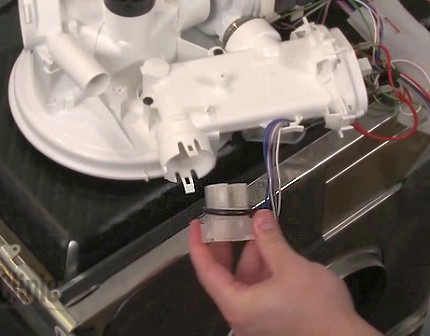
Replacing the pump is easy, but expensive. It is easier to ensure the proper functioning of the device and prevent breakage. This can be ensured by regular cleaning of the filters from dirt, preventing it from getting into water hoses. In the warehouses of service centers, the pump model is almost always available, so there should be no problems with the speed of its replacement.
To deal with the device and the location of the circulation pump of the dishwasher will help a roller that describes the process of disassembling the unit to replace a failed pump:
No. 2 - drain pump
A drain pump is responsible for pumping water out of the dishwasher. It has a small capacity, but is an important node, without which the PMM is impossible.
The pump may break down for the following reasons:
- voltage drops;
- clogging;
- increased load due to excessively long drain hoses.
Signs of an impending breakdown are a buzz when the water is drained and its slow pumping. The pump is quite universal, so replacing it is not difficult. The cost of a new device is about 1000 rubles, and it is usually available at each service center.
No. 3 - control board
Electronic circuits are vulnerable to exposure to most physical factors. Damage to control boards on the PMM is usually caused either by factory defects or by voltage surges in the power supply network. The cost of replacing it ranges from 15-30% of the price of a new dishwasher.
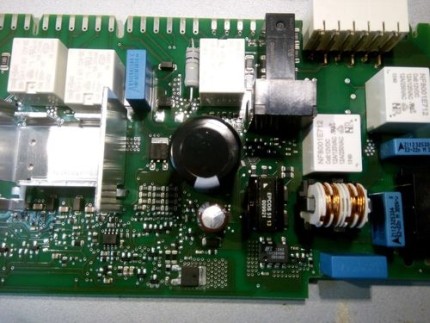
For places with problematic stress, you can advise you to buy it stabilizer, but the cost of such an apparatus will be at least 10,000 rubles.
The motherboards are specific, so it will take a long time to wait for the parcel with the product from the support service center, and it is unlikely to replace it yourself. Therefore, the breakdown of this part will be a big problem, the solution of which will require time and money.
No. 4 - water inlet valve
The inlet valve may break in two cases: burnout of the electromagnetic coil and violation of the tightness of the seal. This problem is rare, but to solve it will have to spend 1500-2500 rubles.
A sign of burnout of the coil will be the lack of water when starting the PMM, because in the off state the valve is closed. If there is a leak, a leak will occur, but to accurately determine its source, you will first need to disassemble the machine.
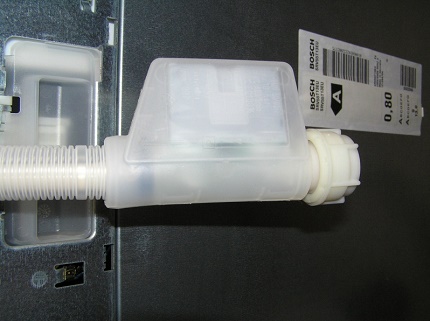
No. 5 - flow heaters and heating elements
Users of the PMM may not notice the inoperability of the heaters for months if the automation does not signal this. Symptoms of the failure of these devices may be deterioration in the quality of washing dishes and an increase in the drying time.
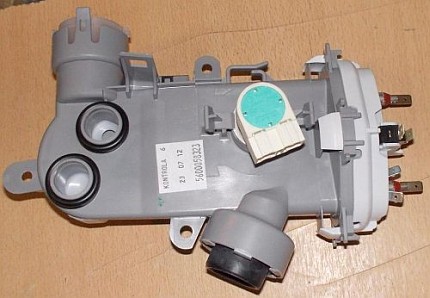
The cost of a new heating element for a dishwasher ranges from 1000 to 3000 rubles. You can replace it yourself, if you know how to get to it.
You can install a heater from a different model on the dishwasher if it is structurally suitable and does not have specific connectors. Therefore, it is possible to eliminate the breakdown of the heating element quickly and inexpensively, and our step-by-step instruction Replacing the heater will help you in this.
No. 6 - elements of drainage equipment
Repairing drainage equipment can be a big problem. Spirals or fans for specific PMM models are rarely found on sites. Therefore, the order of these parts will have to be done only through official service centers.
Lucky for those consumers whose dishwashers can work with failed dryers. And if the automation will give an error, then you have to wait weeks to repair the device.
But you should not worry much about problems with drying, because this equipment is reliable and rarely fails. You can replace the heating coil or fan yourself, but it is better to use the services of the SC.
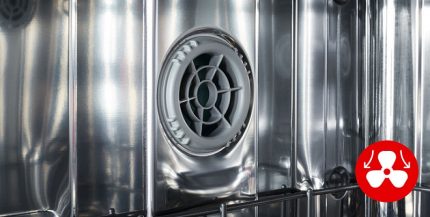
No. 7 - other components of PMM
Almost all parts of the dishwasher can fail. Inaccurate handling of dishes may result in damage to the spray guns or damage to the gaskets. And voltage surges can provoke burnout of sensors, actuators, starters and other electrical devices.
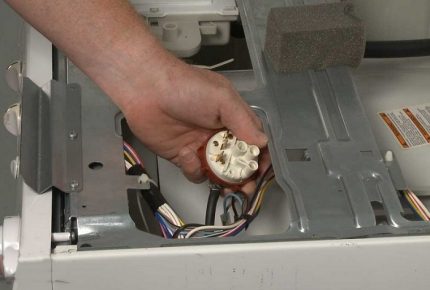
It may also be necessary to replace filters, dispensers, hoses, mounts, and other small parts. It should be remembered that the less often a part breaks and the smaller it is, the higher margins manufacturers will lay in its price. For example, a breakdown of the simplest plastic salt dispenser will result in 5000-6000 rubles.
The high cost of repairing PMM should stimulate consumers to respect it. Then both money and nerves will be saved.
Conclusions and useful video on the topic
The presented video materials will allow you to better understand the device of the dishwasher, see the operation of the machines from the inside and get acquainted with the process of disassembling them.
Dishwasher device:
The dishwasher in the house is gradually becoming the norm, not the exception. But almost any breakdown of this technique will be a strong blow to the wallet.
Therefore, despite its reliability, the PMM requires careful handling and compliance. operating rules.
Still have questions about your dishwasher? Ask them in the comment block - our experts and other visitors to the site will try to help you.
If you want to supplement our material with useful information or recommendations, please write them below under this article.

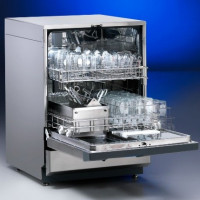 The principle of operation of a typical dishwasher: design, main components, operating rules
The principle of operation of a typical dishwasher: design, main components, operating rules 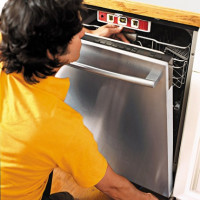 The first start of the dishwasher: how to properly carry out the first inclusion of equipment
The first start of the dishwasher: how to properly carry out the first inclusion of equipment 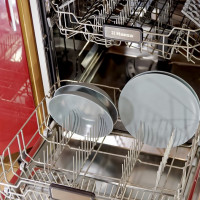 Hansa ZIM 476 H dishwasher overview: functional assistant for one year
Hansa ZIM 476 H dishwasher overview: functional assistant for one year  Tank of the dishwasher: causes and options for breakdowns + ways to eliminate them
Tank of the dishwasher: causes and options for breakdowns + ways to eliminate them 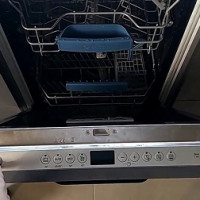 Overview of the Bosch SPV47E40RU dishwasher: economical consumption of resources when washing class A
Overview of the Bosch SPV47E40RU dishwasher: economical consumption of resources when washing class A 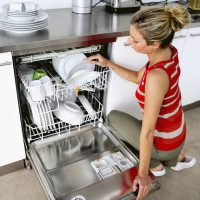 TEN for the Bosch dishwasher: how to choose + replacement instructions
TEN for the Bosch dishwasher: how to choose + replacement instructions  How much does it cost to connect gas to a private house: the price of organizing gas supply
How much does it cost to connect gas to a private house: the price of organizing gas supply  The best washing machines with dryer: model rating and customer tips
The best washing machines with dryer: model rating and customer tips  What is the color temperature of light and the nuances of choosing the temperature of the lamps to suit your needs
What is the color temperature of light and the nuances of choosing the temperature of the lamps to suit your needs  Replacement of a geyser in an apartment: replacement paperwork + basic norms and requirements
Replacement of a geyser in an apartment: replacement paperwork + basic norms and requirements
I read that you can put something on a separate dishwasher on the lid (this, as I understand it, distinguishes them from washing machines on which it is not recommended to put anything on it). Are there any restrictions on the weight and type of what can be put on the lid of the dishwasher? For example, a small microwave - can it be? What about an electric kettle? There is not much space in the kitchen, and I would like to use all surfaces.
There are no restrictions on weight, within reason, of course. The problem with installing the microwave on the dishwasher is that the simultaneous start of both devices can lead to the failure of the control module of the dishwasher. In general, microwave radiation is harmful not only to people, but also to any electrical devices.
Within a reasonable weight and size, you can put on the dishwasher whatever you want. Of course, if you plan to put a microwave oven and an electric kettle, then you need to take care of the wiring, which must withstand the load from such powerful devices.
It is better to connect the dishwasher separately through an individual stabilizer, since this household appliance does not like voltage drops. At home, the dishwasher is built into the furniture, so I forgot about such a distribution of space. There used to be a microwave in the dishwasher and there were no problems.
At the expense of the washing machine, I can say that if it is set according to the level, then it is also suitable for making use of the space on its cover.
I get an error 11. What does this mean please tell me?
Good afternoon! Unfortunately, you did not specify the brand of the dishwasher but, we will try to help you. We list all brands of cars in which error 11 may be displayed:
1. AEG - failure in the operation of the transparency sensor;
2. Bosch - lack of water heating;
3. Electrolux - problems with the transparency sensor;
4. Miele - problems with the discharge of waste water;
5. Neff - lack of water heating;
6. Siemens - the heating element does not work;
7. Whirlpool - failure of the electronic water sensor;
8. Zanussi - a malfunction in the transparency sensor.
Your dishwasher is not on the list? Please write the make and model, and we will try to help you.
Dishwasher Electrolux. After turning on the mode, it works until the first drain and freezes. The drain pump works, and that’s it. Does not give an error, time stops. After a power outage after (at least) six hours, it can work again, but not for long. What could be the reason? Thank.